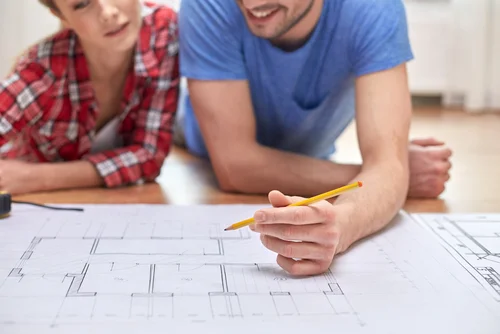5 Mistakes to Avoid When Designing a Custom Floor Plan
Choosing to build a new home often comes after months or even years of dreaming about the perfect home. Maybe you’ve been looking at existing homes with a real estate agent and simply can’t find one that meets your standards. Or maybe you’ve been saving up to build your dream home for years.
Whatever your life circumstances, you’ve reached a point where it’s time to start thinking about your next home – your dream home – and you’re simply not sure where to start.
Like everything in life, a little planning will go a long way in helping you reach your goals and create the best home possible. It’s not as easy as drawing out your own floor plan on the back of a napkin and making it come to life with a few basic selections.
We’ve designed hundreds of home floor plans and helped many families just like yours customize the space to suit their individual needs. It takes a lot of years to learn a thing or two about proper design, to learn how to take what you’re thinking and bring it to reality. We understand this and have discovered there are a few common themes to successful projects when working on your own home floor plans.
#1 Don’t rush the project
The majority of mistakes made in building a home come from rushing through the project. Because you are starting from the ground up, it’s important to take your time and ensure every step of the way is successful in helping you create the best home possible.
Before you ever begin, put together your wish list. With today’s technology, you can do this in a variety of ways. You can start with a house idea book by including pictures and drawings of everything you like. Build a binder filled with ideas to help your builder and contractor get on the same page as you. You can also do it with free online design tools such as Pinterest. Build separate boards with the things you like most. This allows you to show your builder architectural, design, and décor ideas that you want to be built into your home floor plan.
Also, understand your site’s constraints. There are two different ways of building a new home: buy in a new construction neighborhood where lots are pre-designed with specific floor plans, or choose your own lot and custom build to your own expectations. Realize that not every lot can handle every floor plan. You’ll have to check zoning, plat plans for dimensions, setbacks, and guidelines to determine if your designs will fit in the space you desire.
#2 Don’t forget about utilizing a team of experts
Purchasing something intangible such as a service is hard. You can’t feel it, touch it, pick it up and take it home. You have to rely on the expertise of the company you choose to invest in.
With a product, it comes down to the physical characteristics. You can grab a meal at a fast food restaurant or you can select a gourmet catered dinner under the stars. Both include food you can touch, taste and smell. But it’s the experience that changes significantly between the two.
Likewise, the differences between builders and designers aren’t the fact that they can both build you a house; it comes down to the experience they provide throughout the process. A great builder and design team will help you develop your ideas to the fullest, choose home floor plans that meet your every need, helps you cut costs where appropriate, save you headaches along the way, and ensure your project will be successful from beginning to end.
#3 Don’t let your dreams get out of control
The thing about dreaming big with your dream home is that designing can quickly spiral out of control. Yes, you’ve always wanted a gourmet kitchen. Yes, it makes sense to add that extra space now rather than later. And builders, for the most part, have good intentions at heart.
But it takes a special builder and design team to marry your dreams with reality and ensure it all fits neatly within your budget constraints. After all, your builder and design team won’t have to live with the consequences for the next decade or two.
Talk it out with everyone on the team: your spouse, your builder, your designer, even a counsel member or two. Outside experience and thoughts should always be welcome to ensure you’ve thought each step through and clearly understand the restrictions of your design.
Always be up front with incidental costs – do you know how much every step will cost? Do you understand how additions will add to the final costs? Are there ways you can save and still get what you want? These are things we include with all of our designs.
#4 Don’t confuse wants with needs
Go back to your idea book. Sort it based on wants and needs. If you have three kids, you may need a four bedroom house. If you work from home, you may need a home office to separate yourself from the family. But a separate workout space may not be required if it adds thousands to the bottom line. You may find that it would be a nice feature to have, but you can make do in other ways.
Be sure to separate your wants from your needs early. A well-customized design will balance your goals with your ideas to create a great plan you can enjoy for a very long time.
Also look toward the future. Kids don’t stay little for very long. What else could you do with the space? A playroom can turn into a workout space in just a few years. If there is something you want and can’t add into your home floor plan right away, your designer may have great ways of adding the space down the road.
#5 Don’t ignore advice
A good designer doesn’t try to fit you into a space; they listen to you and design the space around your needs. Still, it’s easy to forgo advice and think of your dreams instead. Maybe you’ve always loved the extra large pantry you’ve seen on TV and have dreams of incorporating it into your kitchen. A designer can not only offer you advice, but can make other suggestions instead. Instead of putting all of your kitchen space behind closed doors, for instance, they may have better suggestions for opening it up and making it more functional in your lifestyle.
Designers and builders do this for a living. Don’t discount the advice they have to give. Ask questions if you don’t understand. Sometimes understanding things gives you the ability to look at your floor plan through new eyes. Also, make sure that everyone in the process is communicating well. Your designer, builder, even your spouse need to be on the same page as every change is made. This will ensure your finalized design is one you can live with for many years to come.

